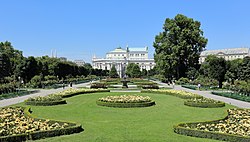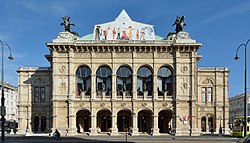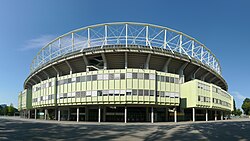The following outline is provided as an overview of and topical guide to Vienna:
Contents
- General reference
- Geography of Vienna
- Location of Vienna
- Environment of Vienna
- Areas of Vienna
- Locations in Vienna
- Demographics of Vienna
- Government and politics of Vienna
- Law and order in Vienna
- International relations of Vienna
- History of Vienna
- History of Vienna, by period or event
- History of Vienna, by subject
- Culture of Vienna
- Arts in Vienna
- Cuisine of Vienna
- Events in Vienna
- Languages of Vienna
- Media in Vienna
- People of Vienna
- Philosophy of Vienna
- Religion in Vienna
- Sports in Vienna
- Economy and infrastructure of Vienna
- Transportation in Vienna
- Education in Vienna
- Healthcare in Vienna
- See also
- References
- External links
Vienna – capital of Austria and one of its nine states. It is the country's largest city, with over 1.8 million residents [1] within an area of 414.65 km2 (160.10 sq mi). Vienna has a rich heritage and is considered one of the most livable cities in the world. It is the cultural center of Austria and a popular tourist destination, attracting over 6.8 million visitors per year. [2] Having become the home of many musical luminaries throughout music's classical period (and later), including Mozart and Beethoven, Vienna is known as the City of Music. [3]


























































